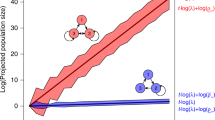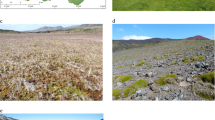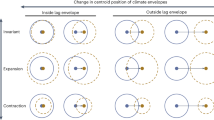Abstract
Non-native plants are now a pervasive feature of ecosystems across the globe1. One hypothesis for this pattern is that introduced species occupy open niches in recipient communities2,3. If true, then non-native plants should often benefit from low competition for limiting resources that define niches. Many plants have evolved larger size after introduction, consistent with increased access to limiting resources4–9. It has been difficult to test whether larger size reflects adaptation to exploit open resources, however, because vacant niches are generally challenging to identify in plants. Here we take advantage of a situation in which a highly invasive non-native plant, Centaurea solstitialis L. (yellow starthistle, hereafter YST), occupies a well-described environmental niche, wherein water is a known limiting resource10,11. We use a glasshouse common environment and climatic niche modelling to reveal that invading YST has evolved a higher-fitness life history at the expense of increased dependence on water. Critically, historical declines in resident competitors have made water more available for introduced plants11,12, demonstrating how native biodiversity declines can open niches and create opportunities for introduced species to evolve increased resource use, a potentially widespread basis for introduction success and the evolution of invasive life histories.
This is a preview of subscription content, access via your institution
Access options
Subscribe to this journal
Receive 12 digital issues and online access to articles
$119.00 per year
only $9.92 per issue
Buy this article
- Purchase on Springer Link
- Instant access to full article PDF
Prices may be subject to local taxes which are calculated during checkout


Similar content being viewed by others
References
Vellend, M. et al. Global meta-analysis reveals no net change in local-scale plant biodiversity over time. Proc. Natl Acad. Sci. USA 110, 19456–19459 (2013).
Daehler, C. C. Darwin's naturalization hypothesis revisited. Am. Nat. 158, 324–330 (2001).
Kennedy, T. A. et al. Biodiversity as a barrier to ecological invasion. Nature 417, 636–638 (2002).
Bossdorf, O. et al. Phenotypic and genetic differentiation between native and introduced plant populations. Oecologia 144, 1–11 (2005).
Mayrose, M., Kane, N. C., Mayrose, I., Dlugosch, K. M. & Rieseberg, L. H. Increased growth in sunflower correlates with reduced defences and altered gene expression in response to biotic and abiotic stress. Mol. Ecol. 20, 4683–4694 (2011).
Dlugosch, K. M. & Parker, I. M. Invading populations of an ornamental shrub show rapid life history evolution despite genetic bottlenecks. Ecol. Lett. 11, 701–709 (2008).
Turner, K. G., Hufbauer, R. A. & Rieseberg, L. H. Rapid evolution of an invasive weed. New Phytol. 202, 309–321 (2014).
Hodgins, K. A. & Rieseberg, L. Genetic differentiation in life-history traits of introduced and native common ragweed (Ambrosia artemisiifolia) populations. J. Evol. Biol. 24, 2731–2749 (2011).
Blumenthal, D. M. & Hufbauer, R. A. Increased plant size in exotic populations: a common-garden test with 14 invasive species. Ecology 88, 2758–2765 (2007).
Hooper, D. U. & Dukes, J. S. Functional composition controls invasion success in a California serpentine grassland. J. Ecol. 98, 764–777 (2010).
Hulvey, K. B. & Zavaleta, E. S. Abundance declines of a native forb have nonlinear impacts on grassland invasion resistance. Ecology 93, 378–388 (2012).
Zavaleta, E. S. & Hulvey, K. B. Realistic species losses disproportionately reduce grassland resistance to biological invaders. Science 306, 1175–1177 (2004).
Shea, K. & Chesson, P. Community ecology theory as a framework for biological invasions. Trends Ecol. Evol. 17, 170–176 (2002).
Levine, J. M. Species diversity and biological invasions: relating local process to community pattern. Science 288, 852–854 (2000).
Strauss, S. Y., Webb, C. O. & Salamin, N. Exotic taxa less related to native species are more invasive. Proc. Natl Acad. Sci. USA 103, 5841–5845 (2006).
Seabloom, E. W., Harpole, W. S., Reichman, O. J. & Tilman, D. Invasion, competitive dominance, and resource use by exotic and native California grassland species. Proc. Natl Acad. Sci. USA 100, 13384–13389 (2003).
Davis, M. A. et al. Don't judge species on their origins. Nature 474, 153–154 (2011).
Widmer, T. L., Guermache, F., Dolgovskaia, M. Y. & Reznik, S. Y. Enhanced growth and seed properties in introduced vs. native populations of yellow starthistle (Centaurea solstitialis). Weed Sci. 55, 465–473 (2007).
Keane, R. & Crawley, M. Exotic plant invasions and the enemy release hypothesis. Trends Ecol. Evol. 17, 164–170 (2002).
Gerlach, J. D. How the West was lost: reconstructing the invasion dynamics of yellow starthistle and other plant invaders of western rangelands and natural areas. Calif. Exot. Pest Plant Council Symp. Proc. 3, 67–72 (1997).
DiTomaso, J. M. & Healy, E. Weeds of California and Other Western States (ANR Univ. California, 2007).
Uygur, S., Smith, L., Uygur, F. N., Cristofaro, M. & Balciunas, J. Population densities of yellow starthistle (Centaurea solstitialis) in Turkey. Weed Sci. 52, 746–753 (2004).
Andonian, K. et al. Range-expanding populations of a globally introduced weed experience negative plant-soil feedbacks. PLoS ONE 6, e20117 (2011).
Galloway, L. F. & Etterson, J. R. Transgenerational plasticity is adaptive in the wild. Science 318, 1134–1136 (2007).
Eriksen, R. L., Desronvil, T., Hierro, J. L. & Kesseli, R. Morphological differentiation in a common garden experiment among native and non-native specimens of the invasive weed yellow starthistle (Centaurea solstitialis). Biol. Invasions 14, 1459–1467 (2012).
Colautti, R. I., Maron, J. L. & Barrett, S. C. H. Common garden comparisons of native and introduced plant populations: latitudinal clines can obscure evolutionary inferences. Evol. Appl. 2, 187–199 (2009).
Erikson, R. L. et al. Dispersal pathways and genetic differentiation among worldwide populations of the invasive weed Centaurea solstitialis L. (Asteraceae). PLoS ONE 9, e114786 (2014).
Colautti, R. I. & Barrett, S. C. H. Rapid adaptation to climate facilitates range expansion of an invasive plant. Science 342, 364–366 (2013).
Broennimann, O. et al. Measuring ecological niche overlap from occurrence and spatial environmental data. Glob. Ecol. Biogeogr. 21, 481–497 (2012).
Petitpierre, B. et al. Climatic niche shifts are rare among terrestrial plant invaders. Science 335, 1344–1348 (2012).
Graebner, R. C., Callaway, R. M. & Montesinos, D. Invasive species grows faster, competes better, and shows greater evolution toward increased seed size and growth than exotic non-invasive congeners. Plant Ecol. 213, 545–553 (2012).
Farquhar, G., Ehleringer, J. & Hubick, K. Carbon isotope discrimination and photosynthesis. Annu. Rev. Plant Physiol. Plant Mol. Biol. 40, 503–537 (1989).
Kriticos, D. J. et al. CliMond: global high-resolution historical and future scenario climate surfaces for bioclimatic modelling. Methods Ecol. Evol. 3, 53–64 (2012).
Warren, D. L., Glor, R. E. & Turelli, M. ENMTools: a toolbox for comparative studies of environmental niche models. Ecography 33, 607–611 (2010).
Verbruggen, H. et al. Improving transferability of introduced species’ distribution models: new tools to forecast the spread of a highly invasive seaweed. PLoS ONE 8, e68337 (2013).
Warren, D. L., Glor, R. E. & Turelli, M. Environmental niche equivalency versus conservatism: quantitative approaches to niche evolution. Evolution 62, 2868–2883 (2008).
Acknowledgements
We thank A. Guggisberg and M.S. Barker for assistance with seed collections; B.M. Anderson, S. Lin and K. Nurkowski for help with greenhouse measurements; D. Kaplan for assistance with greenhouse logistics; O. Broennimann for sharing scripts and advice for climate analyses; and B.M. Anderson and J. Braasch for helpful comments on drafts of this manuscript. This work was supported by funding from a Natural Sciences and Engineering Research Council of Canada grant #353026 to L.H.R., from University of Arizona start-up funds to K.M.D, and from a Postdoctoral Excellence in Research and Teaching (National Institutes of Health program K12 GM000708) fellowship to B.S.B.
Author information
Authors and Affiliations
Contributions
K.M.D. and L.H.R. designed the research. K.A. and S.M.S. contributed seed collections; K.M.D., F.A.C. and B.S.B performed the research. K.M.D. and B.S.B. analysed the data and created the figures. K.M.D. wrote the paper.
Corresponding author
Ethics declarations
Competing interests
The authors declare no competing financial interests.
Supplementary information
Rights and permissions
About this article
Cite this article
Dlugosch, K., Alice Cang, F., Barker, B. et al. Evolution of invasiveness through increased resource use in a vacant niche. Nature Plants 1, 15066 (2015). https://doi.org/10.1038/nplants.2015.66
Received:
Accepted:
Published:
DOI: https://doi.org/10.1038/nplants.2015.66
This article is cited by
-
Distribution models in invasive plants with climatic niche expansion: a case study of Ulex europaeus L. in Colombian Andes
Biological Invasions (2024)
-
Gall size of Dryocosmus kuriphilus limits down-regulation by native parasitoids
Biological Invasions (2021)
-
Increments in weed seed size track global range expansion and contribute to colonization in a non-native region
Biological Invasions (2020)
-
Evidence for evolution of increased competitive ability for invasive Centaurea solstitialis, but not for naturalized C. calcitrapa
Biological Invasions (2019)
-
Phenological and reproductive traits and their response to environmental variation differ among native and invasive grasses in a Neotropical savanna
Biological Invasions (2019)



